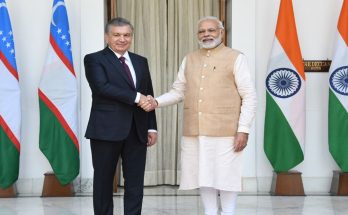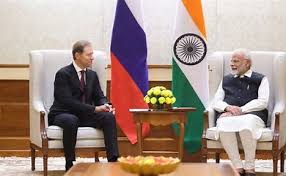The visit of US President Barack Obama to India for the 66th Republic Day was laden with ‘symbolism’ which can be decoded as ‘US is ready to acknowledge India’s rising economic power’. India is after all the third biggest economy in the world and is poised to grow at 7 to 8 per cent according to International Monetary Fund (IMF).
President Obama’s visit to India has given the American business community a signal that India is going to be important for the US business. Other reasons for Obama’s visit could be that he is keen to tap India’s economic potential specially when China’s growth is slowing down and EU is facing a deflationary spiral that could turn into a full-fledged recession.
India as an important member of the BRICS is also close to both Russia and China, two countries that the western powers are wary of. India with its huge population of 1.2 billion of mostly young people is a future powerhouse of the world, ready to supply labour to countries needing it. It will not only be software engineers who would be going to the West but with ageing Europeans, a lot of care givers from India would be needed in EU’s health sector.
Secondly, though there were many issues to be sorted out during the visit, President Obama went for generalities saying he would like to take India US economic relations to new heights. Trade with US was at $63.7 billion in 2013 though now it is nearly $100 billion. India and the US want to see this bilateral trade rise to $500 billion. India had a trade surplus with US at $20.9 million. India and China trade, on the other hand, has surpassed $500 billion (now at $560 billion). India on the other hand, accounts for only 2 percent of US imports and 1 per cent of its exports.
There was much talk of Foreign Direct Investment and the controversial issues relating to the ‘ease of doing business’ in India. Prime Minister Modi promised he would greatly improve the ‘ease of doing business’, important not just for Americans but for other countries as well. India’s ranking is 142nd in the important World Bank index of ‘ease of doing business’ and India is known to have various impediments to FDI starting from lack of speedy clearances, old labour laws and difficulties in land acquisition.
Land acquisition law has been amended by an Ordinance by the Modi government but this will not be accepted easily. Other thorns in the progress of FDI flow are age old bureaucratic hassles and opening up of retail sector in India.
USA’s FDI to India from April 2000 to September 2014 was $13.16 billion constituting nearly 6 per cent of the total FDI into India, making US the sixth largest source of FDI into India. On the other hand, 65 large Indian companies have been investing in the US. They have invested $17 billion so far.
The Bilateral Investment Treaty was talked about during the visit, but since it requires a lot of technical background work, it was not signed. Infrastructure financing and making of smart cities were also discussed in the CEOs meeting and Obama has promised that US Overseas Private Investment Corporation will lend $1 billion to small and medium enterprises in rural areas in India. On the whole he promised $4 billion in investments and loans.
The problems with India Inc. today, however, are mainly related to domestic policies which are constraining growth and domestic investment, and FDI could help a lot. The impact of slow investment has been that the last quarter (Q3) results of companies show very slow profit growth.
Even IT companies have not shown a rapid profit growth. The IT companies’ combined annual net profit growth stood at 6.3 per cent down from 15.4 per cent in the previous quarter and 32.7 per cent in the corresponding quarter, last year. Analysts attribute this to the continued economic slowdown in Eurozone and Japan even though US has been increasing its demand.
Manufacturing growth in India has picked up from negative growth to 6.3 per cent in April to September 2014. Prime Minister Modi’s pet theme of ‘Make in India’ may materialise with the Nuclear Deal being sealed and American companies coming to India to make nuclear reactors in the future. Making domestic defence equipment has been the aim of the NDA government and it has eased FDI norms considerably in the defence sector.
The main problem, however, could be the quality of labour force. It has, however, to be remembered that India’s labour force ( 90 per cent) is mostly employed in the unorganised sector which is without any kind of safety net or skill training facilities. Unless the labour force is given social protection, guaranteeing families’ health, housing and education, the quality of labour force is not going to come up to world standard. Service sector which contributes 57 per cent of the GDP has fewer people working in it but productivity is high.
Hence all the talk of ‘make in India’ has to be backed by social sector protection for the labour force which will make them secure, their productivity will rise. The reason why China was able to attract FDI after opening up in 1979 was mainly due to its highly disciplined, educated and skilled labour force. More than anything, there has to be skill training centres to enable unorganised sector workers to join the organised sector with better wages and a promise for better life to ‘Make in India’ dream come true.
Meanwhile, the stock market has been on the roll before and after Obama’s visit because of the news that India will surpass China ‘s growth by 2015 and the announcement of quantitative easing by European Central Bank-all of which has led to a huge inflow of FIIs. The inflows have raised India’s reserves to $322 billion recently. The rupee would become stronger which would discourage exports in the future. What India needs badly is FDI with it technology transfer and hopefully that would come after Obama’s India visit.
(The writer is a Senior Fellow at Observer Research Foundation, Delhi)
Courtesy:Observer Research Foundation
Author Profile
- India Writes Network (www.indiawrites.org) is an emerging think tank and a media-publishing company focused on international affairs & the India Story. Centre for Global India Insights is the research arm of India Writes Network. To subscribe to India and the World, write to editor@indiawrites.org. A venture of TGII Media Private Limited, a leading media, publishing and consultancy company, IWN has carved a niche for balanced and exhaustive reporting and analysis of international affairs. Eminent personalities, politicians, diplomats, authors, strategy gurus and news-makers have contributed to India Writes Network, as also “India and the World,” a magazine focused on global affairs.
Latest entries
 India and the WorldNovember 26, 2025G20@20: Africa’s Moment – The Once and Future World Order
India and the WorldNovember 26, 2025G20@20: Africa’s Moment – The Once and Future World Order DiplomacyOctober 4, 2025UNGA Resolution 2758 Must Not Be Distorted, One-China Principle Brooks No Challenge
DiplomacyOctober 4, 2025UNGA Resolution 2758 Must Not Be Distorted, One-China Principle Brooks No Challenge India and the WorldJuly 26, 2025MPs, diplomats laud Operation Sindoor, call for national unity to combat Pakistan-sponsored terror
India and the WorldJuly 26, 2025MPs, diplomats laud Operation Sindoor, call for national unity to combat Pakistan-sponsored terror India and the WorldJuly 25, 2025When Fire Ends, Diplomacy Begins
India and the WorldJuly 25, 2025When Fire Ends, Diplomacy Begins







